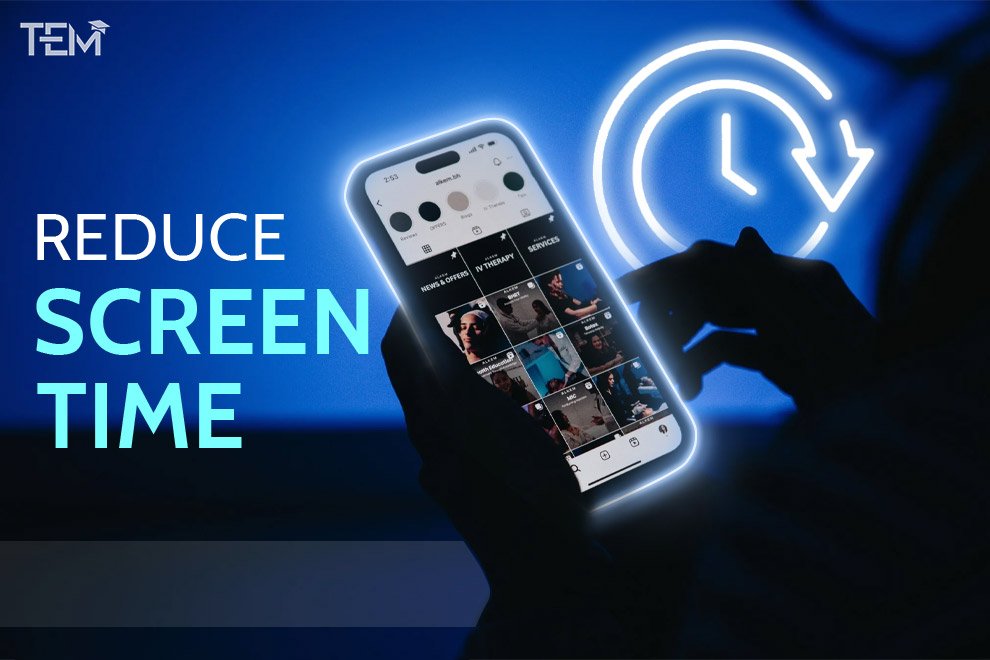Who, What, When, Where, Why
In an age where almost everything—from meetings to grocery shopping—happens online, screen time has soared to all-time highs. Across workplaces, schools, and households in North America and beyond, the average person is exposed to screens for 10 to 12 hours daily, a number that was once considered extreme but is now the norm.
The shift has consequences. Researchers and healthcare providers have linked prolonged screen exposure to sleep disorders, poor posture, digital eye strain, anxiety, and even impaired cognitive function. Policymakers, tech leaders, and wellness advocates now agree: the time to reduce screen time isn’t later—it’s now.
Strategy #1: Set Clear Digital Boundaries
Boundaries are the foundation of digital health. Experts recommend defining where and when screens are allowed, especially at home.
“The most effective screen limits are physical and environmental,” says Dr. Alexis Naranjo, a digital wellness researcher at Stanford University. “Keep screens out of bedrooms, dining areas, and bathrooms. When a device isn’t nearby, the impulse to check it drops dramatically.”
How to implement:
- Designate tech-free zones (e.g., kitchen, bedroom)
- Set phone curfews (e.g., off by 9 p.m.)
- Use device drawers or charging stations away from living areas
Strategy #2: Use Technology to Fight Technology
Ironically, the same devices that contribute to overexposure can help us control it. From Apple’s Screen Time to Android’s Digital Wellbeing suite, built-in tools offer valuable insights.
“It’s not about demonizing tech—it’s about leveraging it wisely,” says Tomás Herrera, Senior Product Manager at Google. “When users realize they spend three hours a day on social media, they’re often shocked. Awareness is the first step to action.”
Effective tech tools include:
- Rescue time for productivity tracking
- Freedom and Cold Turkey to block distractions
- Forest App to gamify staying off your phone
- Focus Mode on Android to pause time-draining apps
Set app time limits and turn off non-essential notifications to significantly reduce screen time passively.
Strategy #3: Adopt the “Digital Sunset” Habit
Blue light emitted by screens suppresses melatonin, the hormone that regulates sleep. Studies show that even 30 minutes of screen exposure before bed can delay REM sleep and reduce sleep quality.
The fix? A “digital sunset”—turning off all screens at least one hour before bedtime.
“We see patients struggling with insomnia not due to stress, but screens,” notes Dr. Reena Shah, a neurologist specializing in sleep medicine. “Creating a wind-down routine that’s screen-free is life-changing for many.”
Try instead:
- Reading a physical book
- Light stretching or breathing exercises
- Journaling or meditating
Strategy #4: Introduce Screen-Free Microbreaks
The 20-20-20 rule—look 20 feet away for 20 seconds every 20 minutes—reduces digital eye strain, but that’s just the start. Short, structured breaks during screen-heavy days boost both mental clarity and physical health.
A study by the University of Illinois found that microbreaks every hour increased productivity by 13% and improved overall satisfaction with work.
Ideas for microbreaks:
- Step outside for 5 minutes
- Do 10 push-ups or deep squats
- Hydrate and walk around
- Talk to a colleague in person instead of messaging
Strategy #5: Replace Screen Time with Purposeful Alternatives
The key to reducing screen time isn’t just limiting it—it’s replacing it.
“Behavior change sticks when it’s driven by value, not guilt,” says Karen Elliot, a behavioral coach and author of The Off-Screen Life. “People don’t just need less screen time—they need more of what screens are replacing: hobbies, movement, relationships.”
Screen-free swaps:
- Replace YouTube with a language class or journaling
- Trade mobile games for board games or puzzle books
- Substitute social scrolling with calling a friend
This substitution method prevents boredom and makes the shift feel rewarding, not restrictive.
Strategy #6: Redesign Your Workday
For professionals, screens are non-negotiable. But how we use them can be changed.
Many companies are now redesigning workflows to accommodate screen breaks. Oxis Capital, a Toronto-based FinTech firm, eliminated back-to-back meetings and instituted a “No-Screens Hour” post-lunch.
“We found productivity went up, not down,” shares Lauren Cho, Chief People Officer at Oxis. “It gave people time to think, strategize, and breathe.”
At an individual level:
- Schedule meetings with breaks in between
- Switch to audio calls when video isn’t necessary
- Print documents when feasible to read offline
Strategy #7: Go on a Weekend Digital Detox
Weekend digital detoxes are gaining traction, with some companies even offering incentives. Whether it’s a family hike without phones or a tech-free Sunday morning, stepping away from screens—fully—helps recalibrate digital habits.
“I went offline every Sunday for a month,” says Marcus Lee, a marketing director based in Vancouver. “I didn’t just reduce screen time. I reduced anxiety and felt more in control.”
Start small:
- Choose one screen-free morning or afternoon
- Turn off Wi-Fi at home for half a day
- Use analog tools like notebooks or printed planners
Conclusion: Reclaiming Control in a Screen-Saturated World
Reducing screen time doesn’t mean unplugging completely—it means taking back control. From software solutions and company culture shifts to individual behavior change, the movement toward digital wellness is gaining traction.
With eye strain, anxiety, and digital fatigue rising, strategies like the digital sunset, microbreaks, and purposeful alternatives offer sustainable relief. The goal isn’t to live without screens, but to live better with them.
As schools, businesses, and families adopt smarter habits, a more balanced future is not only possible—it’s within reach.










